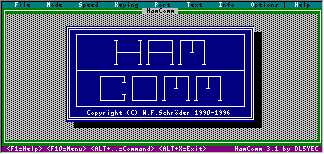

Until recently many of the ham radio operating modes required specialist equipment that most often had to by build and was exclusive to the task. Enter the Personal Computer. The PC made life a little easier for the ham as it was now able to take over some of the jobs that bespoke hardware did. But it still wasn't quite there yet. The task of the PC was mainly to be a 'front end' to a now multi capable bespoke box.
A while went by then some clever bloke worked out how to cut down the cost and complexity of the bespoke hardware and do the whole job in software with a very simple, multi purpose hardware interface. The hamcomm interface was born! So called because it was designed to accompany a software package called hamcomm.
| Its a very easy interface to
build and requires only a few £/$ worth of components. To build it of the
self at Radio Shack would cost
under $5 here in the US.
As you can see by the picture on the right, there's not much to it. To be honest, the picture is misleading. This hamcomm interface has an added 'extra' facility. The original hamcomm interface was RX (receive) only. This one has a TX (transmit) bit added on so that the user can send also. I built the one on the right a few years ago and took its picture using the SSTV equipment that I was building it for. |
 |
|
|
So what can you do with it?
Pretty much anything really. Its most commonly used for the reception of
data modes like RTTY and AmTOR but can be found on simple Fax systems and
of course SSTV systems. I have even seen it used to decode 1200bd packet
radio. Its limited only by the software that is used to run it.
|
Connecting it couldn't be easier. Click here to see how. Enhancements to the basic circuit can be found here.
I'm not going to bother with links etc for this device. There's a load of software and information available on the net. To look for some click here or here.
© & ® Mark A Phillips, G7LTT 1997/8/9/2000
This page was
last updated Sunday
February 13, 2000 16:28 -0000